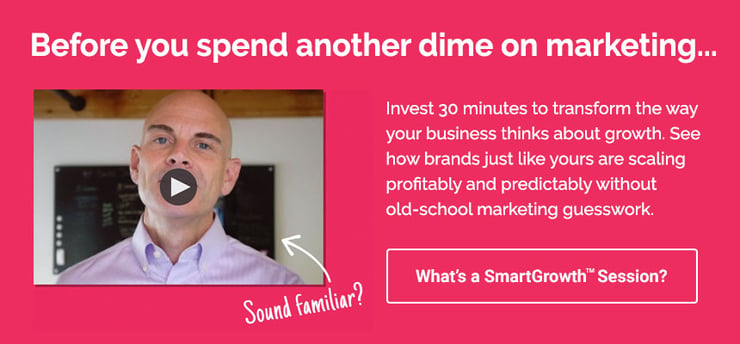Are you tired of pouring time and resources into your B2B website, only to be met with lackluster results? When your website is simply not generating enough leads, it's easy to begin scrutinizing your products or services, or even your pricing. But the real problem is often much simpler – your copywriting. When done right, B2B website copywriting is the difference between a dead-end website and one that turns visitors into high-quality leads all day, every day.
When it comes to creating a website that will generate leads and convert them into customers, many B2B business owners focus on design, functionality, and SEO. But what about the messaging? Your website copy is the glue that binds all those elements together, and failing to nail it could mean lost business opportunities.
The good news is writing website copy that converts isn't rocket science, but it requires a solid strategy and some best practices. In this article, I'll share 13 tips for website copywriting that will help you capture your ideal prospects' attention, speak their language, and get them to take action. Whether you are starting from scratch or launching a website redesign, this post will give you the tools you need to write copy that drives results.
B2B Website Copywriting: How to Nail Your Messaging in 13 Steps
1. Know Your Audience: Your website copy needs to resonate with your target customer. The more you know about who your ideal customer is, their role, and their day-to-day priorities and concerns the easier it is to approach B2B website copywriting with them in mind. Continually strive to understand their needs, pain points, and the solutions they seek and create content and offers that speak to them.
2. Clarify Your Value Proposition: Clearly state what makes your product or service unique. Why should a potential customer choose your company? What makes you different from the competition? What value does your solution deliver? Your UVP should be woven throughout your B2B website copy as well as in blog posts, email newsletters, nurture campaigns, and social media.
3. Focus on Benefits: Instead of listing features, your B2B website copywriting should emphasize the benefits your product or service provides and how it can solve your customers' problems. Is your solution going to save them time? Eliminate a tedious task? Help them collaborate more effectively?
4. Create Content for Every Stage of the Buyer Journey: Your messaging should be different for those who are just getting to know your brand vs those who are about to purchase. Ensure your website speaks to buyers wherever they are in the customer journey. The customer who is just beginning to explore solutions isn’t going to be ready to book a meeting, while the customer who is close to making a purchase doesn’t need to be reintroduced to your solution.
5. Craft Powerful Headlines: Don’t forget the importance of strong headlines in your B2B website copywriting. Your headlines should be compelling and clear, grabbing attention by leveraging emotion and drawing the reader in. They should also be succinct, with no more than 6 to 12 words or 60 to 100 characters.
6. Use Active Voice: Writing in active voice makes your copy more direct, lively, and clear about who is doing what. Active voice is less wordy, easier to understand, and carries a stronger tone than passive voice. This simple step will make all of your B2B copywriting more effective.
7. Employ Short Paragraphs and Bullet Points: Break up text to make it easy to read. Avoid lengthy paragraphs that look like walls of text on a screen. Employ bold fonts or color contrast to emphasize a point or highlight a new section of text. Use bullet points and lists to present benefits or features. In other words, it’s not always what you say, but also how digestible it is to consume and how pleasant it is to look at on the page.
8. Create Strong Calls to Action (CTAs): For B2B websites, often the ultimate goal is not to sell the product but to book a meeting. Your B2B website copywriting should guide visitors towards a specific action (e.g., 'Book a Call,’ 'Subscribe Now’). But clever button wording isn’t enough. You have to compel visitors to take that next step. Why should a visitor book a meeting with you? What’s in it for them? How will this be a valuable use of their time and not a sales pitch?
9. Use Testimonials: Social proof builds trust. Showcase testimonials and case studies from satisfied customers. Highlight statistics collected internally that demonstrate the effectiveness of your solution and gather quotes from happy clients in key industries to bolster visitors’ confidence in your brand.
10. Write for SEO: Incorporate keywords naturally in your B2B website copywriting, particularly in headlines and page titles, and create SEO-friendly meta tags and descriptions. Incorporate a B2B blog strategy in your website to boost organic traffic to your website while providing informative and valuable content for visitors.
11. Avoid Jargon: Keep your B2B copywriting language simple and avoid industry-specific jargon that could confuse readers. Break up long sentences and break down complex concepts so that they are accessible to all readers.
12. Optimize for Mobile: With more people browsing on mobile devices, ensure your copy looks good and reads well on smaller screens. Consider font sizes, color contrast, and dark and light modes when testing web page designs.
13. Be Consistent: Maintain a consistent tone and style throughout your site to provide a cohesive brand experience. Establish a voice that reflects your brand values, resonates with your ideal customer, and offers a touch of personality.
Final Thoughts on B2B Website Copywriting
The power of persuasive copywriting should never be underestimated. Your website is more than just a digital business card—it's a key conversation starter with potential clients, a platform to showcase your values, and a tool to guide prospects toward making a purchase decision. By implementing these 13 tips, you can transform your B2B website into a compelling, conversion-driving machine. Remember, developing compelling website copywriting is not an overnight task, but a continuous process of learning, adapting, and refining. So, don't be discouraged if you don't see immediate results. Keep testing, keep learning, and watch as your words turn browsers into buyers.
At Brand Theory, we design websites and create content for B2B brands seeking sustainable growth through proven tactics. Our content marketing team leverages effective website copywriting strategies and techniques from researching keyword-driven blog posts to drafting irresistible CTAs. If tackling the copywriting for your website feels daunting, schedule a no-obligation introduction to Brand Theory today and discover how an outsourced growth marketing team can help you achieve predictable, profitable growth.




.png)
.png)
.png)